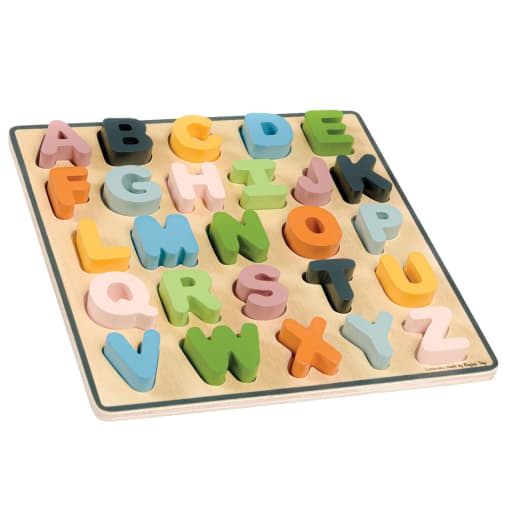Learning your ABCs will be so much fun with this wooden Uppercase Alphabet Puzzle! Each letter is the perfect size for little hands to grab and the color of the letter matches the base slot, making it easier to match. Each base slot has a small letter stamped in a corner to help with letter recognition too! In addition to learning the alphabet, fitting the puzzle pieces into the corresponding spaces helps to promote fine motor skill development. The letters measure 1½” tall and the board measures 11”x11”. For extra practice, check out the Lowercase Alphabet Puzzle as well!
Wooden Uppercase Alphabet Learning Puzzle
SKU
039799
Grade PK
These icons are designed to help you quickly understand and learn important information about our products.
Teaching Method
Traditional
Teacher-centered curriculum commonly used in classrooms that may include a text, teacher manual, tests, etc.
Charlotte Mason
A methodology based on the work of a 19th century educator who maintained that children learn best from literature (Living Books), not textbooks.
Classical
A methodology based on the Latin Trivium (three stages of learning), including the grammar stage (memorization and facts), logic stage (critical thinking), and rhetoric stage (developing/defending ideas).
Unit Study
A thematic or topical approach centered around one topic that integrates multiple subject areas.
Montessori (Discovery)
A methodology based on the work of a 20th century educator that emphasizes student and sensory-driven discovery learning and real-life applications.
Other
Other methodologies
Religious Content
Secular
Contains content contrary to common Christian beliefs (i.e. evolution).
Neutral
Avoids religious or theoretical topics or presents multiple viewpoints without preference.
Christian/Religious
Faith-based or including instructional religious content.
Learning Modality
Auditory
Learns through listening, talking out loud or reading out loud.
Visual
Learns through seeing, prefers written instructions and visual materials.
Kinesthetic/Tactile (Hands-On)
Learns through moving, doing and touching.
Multi-Sensory
Curriculum that employ a variety of activities/components.
Presentation
Sequential
Curriculum progresses through well-defined learning objectives. Emphasizes mastery before moving to the next topic.
Spiral
Topics and concepts are repeated from level to level, adding more depth at each pass and connecting with review.
Conceptual/Topical
Focus is on the “why,” often with a unifying concept as well as specific skills; coverage may be broader.
Teacher Involvement
Low Teacher Involvement
Student-led materials; parent acts as a facilitator.
Medium Teacher Involvement
A mix of teacher-led time and independent student work.
High Teacher Involvement
Teacher-led lessons; may utilize discussions, hands-on activities and working together.
Additional Materials Required
No other materials needed
Everything you need is included.
Other Materials Required
There are additional required resources that are a separate purchase.
Other Materials Optional
There are additional resources mentioned or recommended but are not absolutely necessary.
Consumable
Consumable
Designed to be written in; not reusable.
Non-Consumable
Not designed to be written in; reusable.
Our Price
$39.40 $39.40 $28.95
Rainbow Savings: $10.45
Product Overview
- Learn the Alphabet: Colorful wooden puzzle helps young ones learn their alphabet with capital letters!
- Color-Coded: Promotes letter recognition and memory through colored pieces and slots
- Develops Essential Skills: Enhances fine motor skills and hand-eye coordination while learning the alphabet
Description
Publisher's Description of Wooden Uppercase Alphabet Learning Puzzle
Learning about letters and words is as easy as ABC with our FSC® Certified Wooden Alphabet Puzzle. Each pastel coloured uppercase letter is colour-coordinated with its base slot to help develop recall and recognition skills. The chunky wooden puzzle pieces are perfectly sized for little hands.
Helps to develop dexterity, matching skills and concentration. The wooden base boards of our puzzles are printed with images or colours to aid the learning process and add educational value.
Made from sustainably sourced FSC® Certified wood. Conforms to current European safety standards. 26 puzzle pieces. 18+ months.
FSC® Certified Uppercase ABC Puzzle - product features:
- 26-piece wooden alphabet puzzle
- Made from FSC® Certified wood
- Teaches children how to spell
- Each individual letter is colour coded with its base slot
- Helps develop matching, recall and recognition skills from an early age
- 18 months +
Details
| Product Format: | Other |
|---|---|
| Grade: | PK |
| Brand: | BigJigs Toys |
| EAN/UPC: | 691621830383 |
| Length in Inches: | 11.125 |
| Width in Inches: | 11.125 |
| Height in Inches: | 1.125 |
| Weight in Pounds: | 1.55 |
Videos
Reviews

